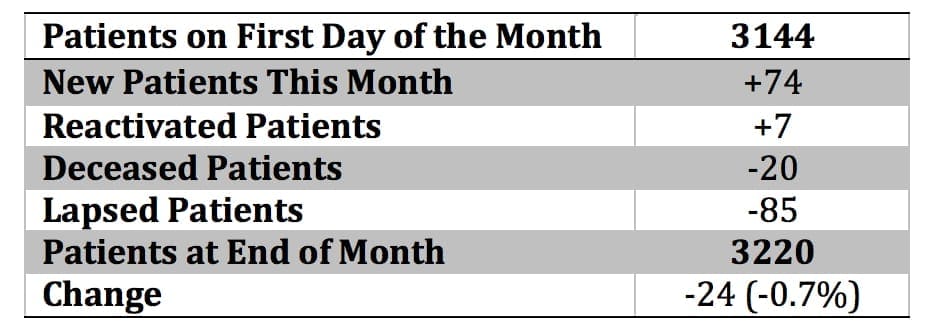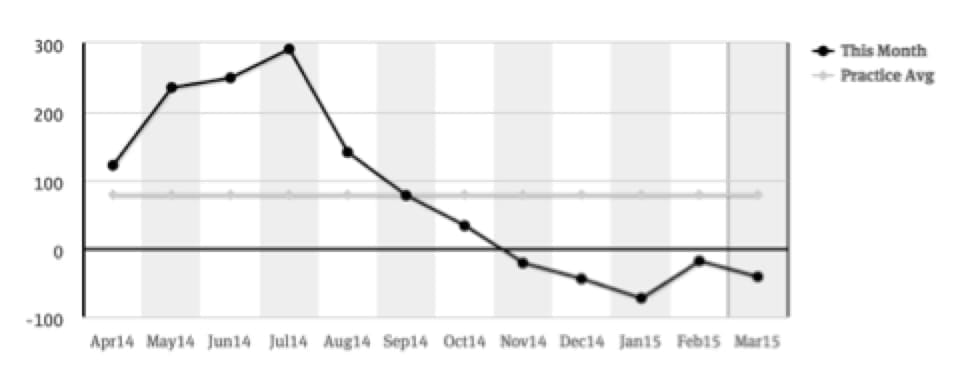What is the importance of active patient count, you may ask? I’ll let Henry answer that!
Dear Liza,
I hope this note finds you well. Things here are great. We had a banner month! Our new marketing program seems to be working, and we saw a record number of new patients in the practice this month. The team is totally engaged and excited. More importantly, very few people seem to have left the practice. We had to say goodbye to relatively few of our friends and our area seems to be growing without people moving out.
We are feeling happy, happy, happy!
Yours truly,
Henry
We Care For Pets Veterinary Practice
Dear Henry,
I’m thrilled that you’re feeling so good about how things are going. There’s nothing better than the wind in your sails. You can practice the medicine you want to practice and sleep at night knowing that you’re doing great work. Your note did remind me of something interesting that I thought I’d share with you.
As you know, I get to look at a lot of practice data and there’s an interesting phenomenon that I’m not convinced we’re fully aware of in our profession.
Have you looked at your ‘reengaged’ and ‘lapsed’ patients – in other words, your active patient count? You may be experiencing new patients and fewer ‘deactivations,’ but you may not actually be growing. Take a look – it’s important.
Fondly,
Liza
Fix-It Veterinary Consulting
Dear Liza,
There’s a hole in my practice, dear Liza, dear Liza! There’s a hole in my practice, dear Liza, a hole!
I can’t believe it. Here I was feeling so great about all the new patients coming in, but I wasn’t looking at my reengaged and my lapsed patients. It looks like there’s a lot of churn around my active patient count.
Thank you for pointing this out – you’re a true friend!
Henry
We Care For Pets Veterinary Practice
Is there a hole in your practice?
Every month, VetSuccess runs reports for hundreds of veterinary practices. Of all the data we look at, the active patient count is one of our favorite and most powerful areas of inquiry. Why? Because [bctt tweet=”you need to understand your active patient count – especially how it ebbs and flows – in order to know whether your practice is growing or contracting,”] and THAT is some of the most basic and important information to have.
There are three topics to look at when talking about active patient counts. The first topic, hinted at in the exchange between Liza and Henry above, is the fundamental issue of how you calculate active patients. Also important is the timeframe you use and, lastly, a simple classification of patients in your practice.
[bctt tweet=”By focusing on these three topics – calculation, timeframe, and classification – a practice can identify trends and minimize turnover.”]
Let’s take a look at each.
- Calculating your active patient count
- Paying attention to the timeframe of your active patient count
- Classifying active patients
- Jump to summary
-
Calculating your active patient count
Henry reports that new patients are growing while deceased and inactive patients are small. But the active patient count is flat or declining.
Is your practice really growing or is there a leak somewhere that you haven’t considered when it comes to calculating active clients? The answer lies in making sure that you don’t just look at the two most obvious inflows and outflows of patients – new clients (inflows) and deceased and inactives (outflows).
So, Henry is celebrating because his math goes something like this:

But in reality, Henry hasn’t considered his reactivated or lapsed patients in his calculations.
A reactivated patient represents a net inflow – an addition – to your active patient count. These are patients for which there hasn’t been a transaction in the practice for more than 19 months. Suddenly the patient is back and is now a current client.
In contrast, and critically, a lapsed patient represents a net outflow to your active patient count. These are patients for which this month (the month you’re making a calculation for) represents the 18th month since the client was last in the practice.
In September of 2015, lapsed patients represent those for which the last transaction in the practice was in March of 2014. The practice has had 18 months to engage these patients and get them back into the practice. They were current, then lapsing, and now, after the 18th month, need to be considered lapsed and should be deducted from your active patient count.
Suddenly Henry’s math looks different. Look what happens when you include reactivated and lapsed patients in the calculations:

[bctt tweet=”Including all inflows and outflows of your active patients is a highly effective way to telegraph trends in your practice.”] The change in your active patient count can then be charted on a rolling 12-month basis and the average change calculated.
Here is an example of a large practice that is growing at an average of just under 100 new patients per month. This practice is growing – not necessarily from a revenue perspective (that’s a whole different conversation) but from an opportunity to provide service, the practice is growing. And yet, there’s a disturbing trend line that’s important to pay attention to.

– Include reactivated and lapsed patients in your active patient count
– Chart your active patient count on a rolling-12-month basis and review the trend
– Review your reminder protocols to minimize lapsed patients
-
Paying attention to the timeframe of your active patient count
Periodically we still find practices that will question our active patient count numbers when we pull a report. We’ll run numbers and say something to the effect of: “Congratulations! You have 3,698 active patients.” The practice owner will furrow his or her brow and respond with something like: “That seems lower than I expected.”
When we probe a bit further, we find that the question turns on what the practice uses as their definition of an active patient. We’re in favor of a 12-month or 18-month timeframe. We use each of these timeframes in different circumstances. In both cases we look at the elapsed time since there was a transaction (any transaction) on the patient’s file.
It turns out there are still practices that are using an indefinite or default timeframe. The practice considers an active patient to be any patient not marked as inactive or deceased. To these practices we ask the question: “Can you predict how many patients you will see (or, how much revenue you’ll generate) from patients who haven’t visited your practice in more than 18 months?
The answer: “No. No we can’t.”
The reason is that by the time you get to a 19th month, that patient is no longer a preventive care or wellness patient. You may see them again, but it will be when there’s a real health issue.
The case for a 12-month active patient timeframe
There are good reasons to consider as active any patient with a transaction on their file in the last 12 months. This is useful when answering a question like: “How many – or what percent – of my active patients had a wellness exam (or blood test, or dental prophy, etc.)?” In these cases, a 12-month number helps you look at rolling 12-month trend lines, spot seasonality, and avoid potential double-counts.
The case for an 18-month active patient timeframe
This is our favorite timeframe for gauging practice health and taking real action. Here’s why. There are pet owners who, with the best intentions, plan to bring their pet to the vet every 12 months…but they don’t. The visit leaks to 14 months or more. A 12-month definition of active patient considers these otherwise conscientious pet owners as inactive or lapsed. The 18-month definition gives practices enough time to take action and ensure that the patient doesn’t actually lapse.
And it’s this activity, focusing on lapsing patients, that leads to an important conversation about classifications and ultimately helps grow your active patient count.
Actions:
– Look at your active patients from an 18-month perspective. While it increases your count, it also gives additional time for clients to bring their patients in.
-
Classifying active patients
[bctt tweet=”When working on retention and patient growth initiatives, you should measure both your current patients and lapsing patients. We treat these two groups differently.”]
Active Patients = Current Patients + Lapsing Patients
A current patient is any patient for which there is a transaction in the practice (any transaction) in the last 0 – 13 months. A lapsing patient is any patient for which the last transaction was 14 – 18 months ago. Active patients equal the sum of your current and lapsing.
Consider these two practices:
Practice A:

Practice B:

Of all patients seen in the last 36 months, Practice A has 17% more patients that they’ve seen in the last year. We generally like to see current patient counts in the high sixty percent or low seventy percent range and lapsing patient counts at less than 10%.
Understanding and focusing on their lapsing patients has proven extremely effective in:
– Increasing current patient count
– Decreasing lapsed patients
– Actively minimizing or closing a potential hole in the practice.
– Split your active patients into current patients and lapsing patients
– Actively manage your lapsing patients by:– Calling them to reactivate them
– Setting up a reactivation stream of emails to engage them
– Cleaning up your data to ensure that they should in fact be considered ‘active
In summary
Measuring and managing your practice’s active patient count is a highly effective way to understand your practice’s performance. There are three important topics to help you manage active patients like a Well Managed Practice:
- Calculate your active patient count including all inflows and outflows. Don’t forget to add reactivated patients and subtract lapsed patients from your active patient counts. This is a more accurate picture of what’s really happening in your practice.
- Pick a timeframe. When comparing your performance over a time-period for a particular product or service area, use the last 12-months as your timeframe. For a broader, more accurate view of your active patient count, look at patients with a transaction on file in the last 18 months.
- Include current and lapsing patients in your definition active patients. This distinction focuses your practice on making sure that lapsing patients stay current and don’t become lapsed after the 18-month mark.
[bctt tweet=”By proactively managing your active patient count you can spot disturbing trends and get a true sense of whether your practice is expanding or contracting (and at what rate).”] You can also take action to make sure that there aren’t any holes in your practice.
Ready to take action? Check out RETRIEVER — an automated email program that helps you reach lapsing patients who have had no transactions in your practice for 14, 16 and 18 months – without lifting a finger.
This article on the importance of understanding your active patient count first appeared in the 2015 edition of “Benchmarks 2015: A Study of Well-Managed Practices” published by Wutchiett-Tumblin and Associates in conjunction with Veterinary Economics.
Martin Traub-Werner is the dedicated founder of VetSuccess. His number one focus is providing the most value possible to VetSuccess members – and he loves to talk data so don’t hesitate to contact him.
This blog has been updated and was originally published on December 19, 2015



